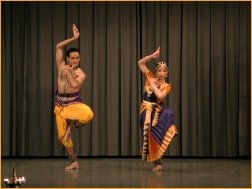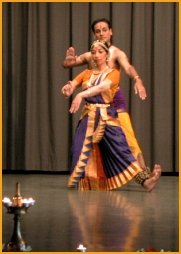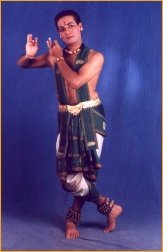 |
 |
BANGALORE DANCE RESONANCE IN BERNE, SWITZERLAND by Linda Eisele, Berne, Switzerland
|
 |
 |
 |
| November
2002
Saturday, November 2, 2002, I had the great pleasure of attending a Bharatanatyam dance recital at the Hochschule für Architektur and Technik in Berne, Switzerland. Christian Meyer, president of the Verein Pro Schule Bangalore, presented a brief history of the school founded in 1994 in Bangalore with 49 students and one teacher. Since 1994, the school has grown to over 250 students, 7 teachers and 1 assistant. The Verein created in 1999 provides books and other materials, 1 meal per day for each student, and clothing to provide an education for children whose parents could not otherwise afford to send them to school. Dancers, Sathyanarayana Raju, Director of the Samskruthi Dance School of Bangalore, and Lakshmi K Devadas of Fribourg graciously donated all proceeds from their dance performance to benefit the school. Mr. Meyer introduced Mr. Maurer who told us about the special Bharathanatyam South Indian temple dance form. Shri Sathyanarayana Raju is a Bharathanatyam, Kuchipudi, and Kathak dancer and choreographer from Bangalore, India. He is renowned for his precise and detailed interpretation of the classical form of Bharathanatyam. Director of the dance school, ‘Samskruthi,’ in Bangalore, he started his dance education with Guru Subhadra Prabhu and is now continuing with Guru Narmada and Guru Bhanumathi in Bangalore. He has previously performed and conducted dance workshops in Switzerland and America. Shrimati Lakshmi K Devadas is a Bharathanatyam dancer from Coimbatore, now living in Fribourg, Switzerland. Lakshmi began her Bharathanatyam education in the Tanjore Pandannalur style with Guru Ganapathiappan in Coimbatore, India, and continues her dance education with Guru Sathyanarayana Raju in India. She also trains with Smt. Maithry Rao in Bangalore, and Shri. D. Keshava from Basel. “In the dancers, you can see a form of their honoring God,” Mr. Maurer says. “In Indian culture, song is always a form of praising god. Indian dance is almost always danced to a song. The dances are very complex and never repeat. The dancer is the servant of the lord. Sathya Raju gives a very precise interpretation of Bhararthanatyam dance. In this first dance, Pushpanjali, (Raga Amrthavarshini), you will see a flower chain, a call from God to you, which will join you with the dancers in a form of prayer." The second dance, Ananda Natanam Aduvaar, (Raga Poorvakalyani), is a remembrance of the Cosmic World Dance. Sathya Raju depicts Lord Nataraja as he dances to create the world. In so doing, Lord Nataraja releases a demon, Muyalaga, and a snake, Ganga. He ensnares Ganga in his matt of hair, kills Muyalaga, standing on him with his foot and lifting his left foot. He adorns the serpent as his ornament. As Sathya Raju dances, his facial expression, eyes, eyebrows, mouth are part of the dance. He wears bells around his ankles, slaps the ground with his bare feet as though these are musical instruments. He is musician and dancer. The third dance, Devaranama, Hariaadiutha, (Raga Hamsanandi) is danced to a popular composition from Saint Purandaradasa, which describes the divine dance of Lord Krishna to the accompaniment of bells. Lord Krishna is adorned with a pearl necklace at his throat, a crown jewel on his head, and bracelets on his hands. Saint Purandaradasa who composed a few hundred wonderful songs, set standards in Carnatic music, especially dance music. As we listen and watch, the dancers make Purandaradasa’s song visible before our eyes. The fourth dance, Thillana, (Raga Ratipatipriya), is a dance of ecstasy and joy. Sathya displays a succession of foot rhythms and sculpturesque poses with playful eyes, graceful movement of arms and body. I can still see his eyebrows trembling when I think of this. The dance is pure rhythms. Sathya’s precision is breath taking, his agility and stamina astounding, his aramandi impeccable. How complex is the dance! Each movement of his body tells the story described by song. Fingers and hands, face, eyes, brow, lips, every part of him tells the story. He has become the story. It appears as if he is a god made flesh. When the movement of the dance hangs suspended, his balance is perfect; the silence of the bells, pure. The final dance, Nagendraharaya, (Raga Ragamallika), is a hymn in praise of Lord Shiva who wears a snake around his neck and has a third eye on his forehead, always pure, with the Ganges river flowing from his head and sandal paste on his skin. Lord Shiva makes the Ganges when he lets water fall from heaven to save the earth. That is why, to this day, people find salvation in the great river. Even the sun and the moon bow to Lord Shiva, and those who recite all these 5 paragraphs every day will be blessed by Shiva, the Lord of the Dance. Sathya and
Lakshmi, man and woman, appear in poses like sculptures. They are works
of art. Every part of them dances - their fingers, eyes, eyebrows,
faces, mouths, feet. They are god and goddess. When they have
finished, there is a thunderous applause. I am in awe of the discipline,
the mesmerizing elegance and control, the divine artistry and intelligence,
the beauty of what I have seen. After the dance, even offstage, Sathya
and Lakshmi are so graceful, with a beauty so pure, the illusion remains
that the gods have walked among us.
Linda Eisele
is an American writer living in Berne Switzerland. She writes articles
for the newsletter of the International Club of Berne, as well as short
stories and poems.
|